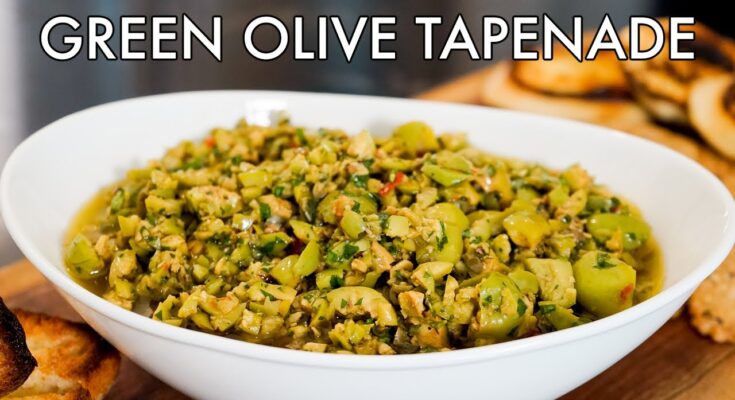Olive Tapenade Recipe: Olive tapenade is a savory spread made primarily from finely chopped olives, capers, anchovies, and olive oil. It’s a Mediterranean delight, especially popular in French cuisine. Think of it as a powerhouse of flavor — salty, tangy, and rich all at once. Some versions are chunky, while others are smooth like a paste. Whichever way you prefer, tapenade is your ticket to an elevated snack board or an easy flavor boost to your meals.
Origin and History of Tapenade
The word “tapenade” comes from the Provençal word tapenas, meaning capers. While olives are a major ingredient, the original recipe was actually more caper-focused! This culinary gem dates back to ancient times when Mediterranean people preserved food with salt and oil. Today, it’s a staple at French bistros and in many Mediterranean households, carrying that old-world charm into modern kitchens.
Why You’ll Love This Olive Tapenade Recipe
Quick and Easy to Prepare
One of the best things about olive tapenade is how quickly it comes together. Seriously, you can whip up a batch in under 10 minutes! It’s perfect for last-minute guests, impromptu gatherings, or just when you crave something bold and flavorful without spending hours in the kitchen.
Versatile and Flavorful
Tapenade isn’t just for crackers (though it’s divine on them!). Use it as a sandwich spread, a pizza topping, or even a sauce for grilled fish or chicken. The intense umami flavor makes it a hero ingredient that can rescue even the most boring of dishes.
Ingredients You’ll Need
Types of Olives for Tapenade
Choosing the right olives is crucial for a killer tapenade. Typically, you want a combination of:
- Kalamata Olives: Rich, fruity, and meaty.
- Niçoise Olives: Traditional for French tapenade; small but mighty in flavor.
- Green Olives: Lighter and slightly bitter, offering a nice balance.
It’s best to go for olives packed in brine rather than oil for better control over the saltiness.
Other Essential Ingredients
Besides olives, you’ll need:
- Capers: Adds a briny tang.
- Anchovies: Brings deep umami (optional if you’re vegetarian or vegan).
- Garlic: A little goes a long way.
- Lemon Juice: Brightens up the mix.
- Olive Oil: Binds everything together.
- Herbs (Thyme, Basil, or Oregano): For aromatic depth.
Pro tip: use the best quality olive oil you can get — it makes a difference!
Equipment Needed
Kitchen Tools for Making Tapenade
You don’t need anything fancy. Here’s what you’ll use:
- Food Processor: Speeds up the chopping and blending.
- Knife and Cutting Board: If you prefer hand-chopped for a chunkier texture.
- Measuring Cups and Spoons: To get the proportions just right.
- Airtight Container: For storage.
Simple tools, stunning results!
Step-by-Step Guide to Making Olive Tapenade
Step 1: Gather Your Ingredients
First things first — lay out everything. Check if the olives are pitted. If not, you’ll need to pit them yourself. Trust me, it’s worth it for that authentic, fresh taste.
Step 2: Preparing the Olives
Rinse the olives under cold water to remove excess brine. This helps in controlling the saltiness later. Same goes for the capers — a quick rinse keeps the flavor vibrant and not overwhelmingly salty.
Step 3: Blending the Tapenade
Toss the olives, capers, anchovies, and garlic into a food processor. Pulse a few times until the mixture is coarsely chopped. Don’t overdo it; you want texture, not baby food!
Step 4: Adjusting Flavor and Texture
Add lemon juice and start drizzling in olive oil while pulsing. Stop and taste frequently. Need more zing? Add more lemon. Too thick? Add a splash more oil. Play with it until it’s just right for you.
Step 5: Storing and Serving
Transfer the tapenade into an airtight container. Let it sit for at least an hour before serving — the flavors meld beautifully. It keeps in the fridge for up to a week, and actually tastes better the next day!
Tips for the Perfect Olive Tapenade
Choosing the Right Olives
Not all olives are created equal. For a tapenade that’s bursting with flavor, avoid canned olives that taste bland or metallic. Instead, opt for high-quality brined olives from a deli or the olive bar at your grocery store. Kalamata olives offer a fruity, meaty depth, while Niçoise olives give a more traditional French flavor. A mix of different varieties can add complexity and layers to your tapenade.
Another important tip: make sure the olives are pitted before you blend. If not, you’ll have a very unpleasant surprise in your first bite. Plus, pits can seriously damage your food processor blades!
Balancing Flavors
A good tapenade is all about balance. Olives and capers bring saltiness, while anchovies add that elusive umami. Garlic gives it heat, and lemon juice cuts through the richness. When tasting your tapenade, think about these flavor notes:
- If it’s too salty, add a few more olives (rinsed thoroughly).
- If it’s too bitter, a tiny bit of honey or a sweeter olive oil can help.
- If it feels flat, more lemon juice or a pinch of fresh herbs can liven it up.
Trust your palate. Taste as you go and adjust until it sings.
How to Serve Olive Tapenade
Best Pairings and Dishes
Olive tapenade is incredibly versatile. Here are some ideas to get you inspired:
- As a Dip: Serve it with crusty bread, pita chips, or vegetable sticks.
- On Toasts: Top crostini with tapenade and a sliver of fresh mozzarella or goat cheese.
- In Sandwiches: Spread it inside a baguette with roasted veggies or grilled chicken.
- As a Pizza Base: Swap tomato sauce for tapenade for a savory, Mediterranean twist.
- With Seafood: Spoon a little over grilled fish, shrimp, or calamari for an instant flavor bomb.
Feeling fancy? Try it alongside a cheese board, nestled among nuts, cheeses, and cured meats. It brings an unexpected punch that cuts through creamy cheeses beautifully.
Variations You Can Try
Sun-Dried Tomato Tapenade
Want a slightly sweeter, more vibrant version? Add sun-dried tomatoes to the mix. Their tangy sweetness balances the saltiness of the olives perfectly. Just toss a handful into the processor along with the other ingredients. It’s a simple twist but feels like a gourmet upgrade.
Spicy Olive Tapenade
If you like a little heat, add a red chili pepper or a pinch of red pepper flakes. The spice wakes up the flavors and makes it an even more exciting condiment. Be careful though—a little goes a long way!
Experiment freely! Tapenade is forgiving and invites creativity.
Storage Tips
How Long Does Olive Tapenade Last?
Properly stored in an airtight container in the fridge, olive tapenade will stay fresh for up to one week. The flavors actually deepen over time, making day-two tapenade even better than fresh!
If you want to keep it longer, freeze it in small portions (ice cube trays work great!). When you need a quick appetizer or spread, just thaw and serve. One thing to remember: always drizzle a thin layer of olive oil over the top before refrigerating or freezing. This helps to preserve the tapenade and keep it moist.
FAQs about Olive Tapenade Recipe
1. What is olive tapenade made of?
Olive tapenade is typically made with black or green olives, capers, garlic, lemon juice, and olive oil. Some variations also include anchovies, fresh herbs, or sun-dried tomatoes for added depth of flavor.
2. Is olive tapenade healthy?
Yes, olive tapenade can be a healthy addition to your diet when eaten in moderation. It’s rich in healthy fats from olives and olive oil, and contains antioxidants and anti-inflammatory properties.
3. Can I make olive tapenade without anchovies?
Absolutely! Anchovies add a savory, umami taste, but they’re optional. You can skip them or use a vegetarian alternative like miso paste for a similar depth of flavor.
4. How long does homemade tapenade last?
Stored in an airtight container in the refrigerator, homemade olive tapenade can last up to one week. For longer storage, you can freeze it in small portions for up to 3 months.
5. What’s the best way to serve olive tapenade?
Tapenade is versatile. Serve it as a spread on crackers or baguette slices, as a topping for grilled chicken or fish, or stirred into pasta or salads for a briny, bold kick.
6. Can I use green olives instead of black olives?
Yes! Green olives give a sharper, more tangy flavor, while black olives offer a milder, earthy taste. Feel free to mix both for a balanced twist.
7. Do I need a food processor to make tapenade?
A food processor makes it easier and faster, but you can also chop all the ingredients finely by hand for a rustic texture.
Conclusion
Making olive tapenade at home is not only easy but incredibly rewarding. With just a few pantry staples and a food processor, you can whip up a delicious, gourmet spread in minutes. Whether you’re entertaining guests or just treating yourself to a special snack, tapenade adds that “wow” factor with minimal effort. Customize it, play with flavors, and most importantly—enjoy every bite. Get ready to make this recipe a permanent staple in your kitchen repertoire!



